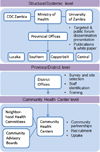HIV Prevention in Resource Limited Settings: A Case Study of Challenges and Opportunities for Implementation
- PMID: 24604206
- PMCID: PMC4721251
- DOI: 10.1007/s12529-014-9397-3
HIV Prevention in Resource Limited Settings: A Case Study of Challenges and Opportunities for Implementation
Abstract
Background: Sub-Saharan Africa has the highest global prevalence of HIV, and the prevention of transmission between HIV-seropositive and -serodiscordant sexual partners is a critical component of HIV prevention efforts. Behavioral interventions that have demonstrated efficacy in reducing risk behaviors associated with HIV transmission and infection and have been translated, or adapted, to a variety of settings.
Purpose: This manuscript examined implementation of behavioral interventions within resource limited health care delivery settings, and their adoption and integration within service programs to achieve sustainability.
Methods: The CDC/Partner Program, an evidence-based risk reduction intervention, was implemented in Community Health Centers (CHCs) in Zambia using a staged technology transfer process, the Training the Trainers Model. Provincial workshops and training workshops on the provision of the intervention were used to establish a cadre of trainers to provide on-site intervention facilitators capable of ultimately providing coverage to over 300 CHCs.
Results: CHC staff provided the intervention to clinic attendees in four provinces over 4 years while also training new facilitators. The implementation process addressed multi-level issues within the context of training, consultants, decision making, administration, and evaluation as well as practical considerations surrounding travel, training, staff compensation and ongoing quality assurance.
Conclusions: The majority of challenges to implementation and maintenance were addressed and resolved, with the exception of structural limitations related to restricted resources for personnel and funding. Strengths of the program included its collaborative structure, active program leadership, commitment and support at the provincial level, the use of task shifting by existing clinic staff, the train the trainer model and ongoing quality control. Enhanced infrastructure is needed in for future implementation, such as training centers within each province, certified expert coaches and annual workshops and system changes to ensure available staff.
Conflict of interest statement
Figures
Similar articles
-
Implementation of HIV prevention interventions in resource limited settings: the partner project.J Community Health. 2014 Feb;39(1):151-8. doi: 10.1007/s10900-013-9753-2. J Community Health. 2014. PMID: 23963855 Free PMC article.
-
Dissemination of the Spear & Shield Project using a Training of Trainers Model: A reflection on challenges and successes.Transl Behav Med. 2022 May 26;12(5):622-629. doi: 10.1093/tbm/ibac013. Transl Behav Med. 2022. PMID: 35312766 Free PMC article.
-
Translation and sustainability of an HIV prevention intervention in Lusaka, Zambia.Transl Behav Med. 2014 Jun;4(2):141-8. doi: 10.1007/s13142-013-0237-9. Transl Behav Med. 2014. PMID: 24904697 Free PMC article.
-
Prevention Interventions for People Living with HIV in Military Settings.Curr HIV Res. 2017;15(2):90-94. doi: 10.2174/1570162X15666170516165331. Curr HIV Res. 2017. PMID: 28176645 Review.
-
Voluntary counseling and testing for couples: a high-leverage intervention for HIV/AIDS prevention in sub-Saharan Africa.Soc Sci Med. 2001 Dec;53(11):1397-411. doi: 10.1016/s0277-9536(00)00427-5. Soc Sci Med. 2001. PMID: 11710416 Review.
Cited by
-
"Someone who is in this thing that I am suffering from": The role of peers and other facilitators for task sharing substance use treatment in South African HIV care.Int J Drug Policy. 2019 Aug;70:61-69. doi: 10.1016/j.drugpo.2018.11.004. Epub 2019 May 10. Int J Drug Policy. 2019. PMID: 31082664 Free PMC article.
-
Understanding barriers and facilitators to voluntary medical male circumcision and Spear and Shield uptake in Zambian community health centers.Transl Behav Med. 2022 May 26;12(5):613-621. doi: 10.1093/tbm/ibac007. Transl Behav Med. 2022. PMID: 35195269 Free PMC article.
-
Let us fight and support one another: adolescent girls and young women on contributors and solutions to HIV risk in Zambia.Int J Womens Health. 2017 Sep 28;9:727-737. doi: 10.2147/IJWH.S142232. eCollection 2017. Int J Womens Health. 2017. PMID: 29033613 Free PMC article.
-
Development and evaluation of a pilot nurse case management model to address multidrug-resistant tuberculosis (MDR-TB) and HIV in South Africa.PLoS One. 2014 Nov 18;9(11):e111702. doi: 10.1371/journal.pone.0111702. eCollection 2014. PLoS One. 2014. PMID: 25405988 Free PMC article.
-
Advancing the science of dissemination and implementation in behavioral medicine: evidence and progress.Int J Behav Med. 2015 Jun;22(3):277-82. doi: 10.1007/s12529-015-9490-2. Int J Behav Med. 2015. PMID: 26001382
References
-
- Townsend L, Mathews C, Zembe Y. A systematic review of behavioral interventions to prevent HIV infection and transmission among heterosexual, adult men in low-and middle-income countries. Prev Sci. 2013;14(1):88–105. - PubMed
-
- Saleh-Onoya D, Reddy PS, Ruiter RA, Sifunda S, Wingood G, van den Borne B. Condom use promotion among isiXhosa speaking women living with HIV in the Western Cape Province, South Africa: a pilot study. AIDS Care. 2009;21(7):817–825. - PubMed
-
- Glasgow RE, Goldstein MG, Ockene JK, Pronk NP. Translating what we have learned into practice. Principles and hypotheses for interventions addressing multiple behaviors in primary care. Am J Prev Med. 2004;27(2 Suppl):88–101. - PubMed
-
- Republic of Zambia Ministry of Health and National AIDS Council. [Accessed 13 Jun 2013];Monitoring the Declaration of Commitment on HIV and AIDS and the Universal Access: Biennial Report. 2010 http://data.unaids.org/pub/Report/2010/zambia_2010_country_progress_repo....
Publication types
MeSH terms
Grants and funding
LinkOut - more resources
Full Text Sources
Other Literature Sources
Medical




